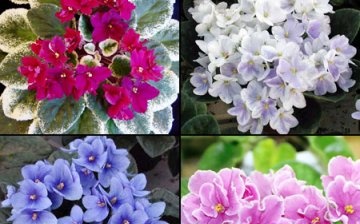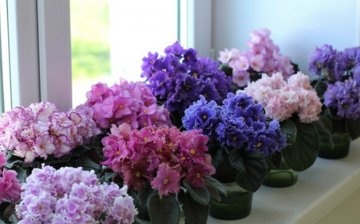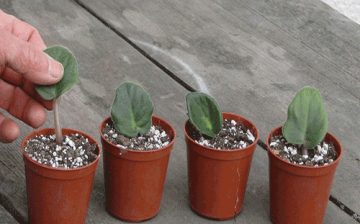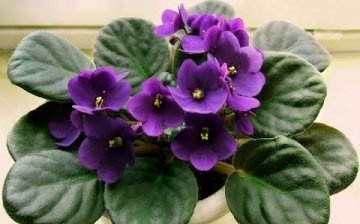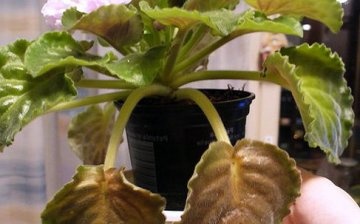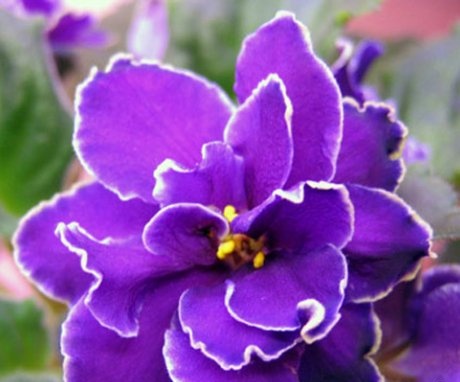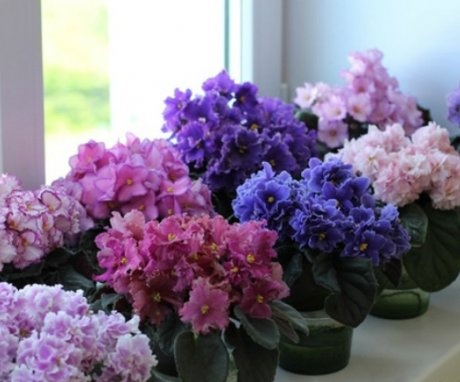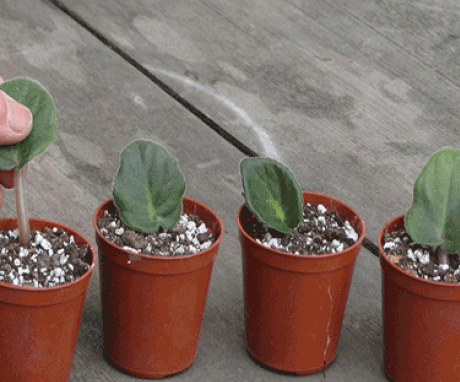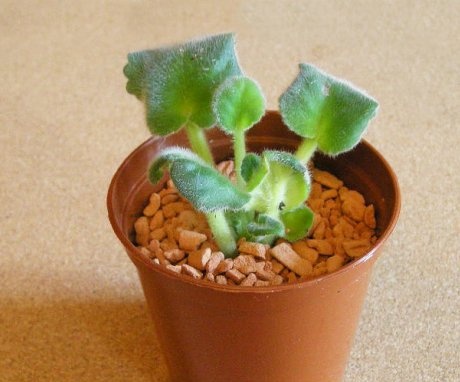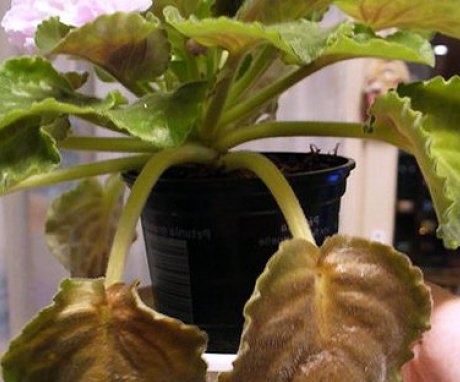The most beautiful types and varieties of indoor violets
Violet remains a favorite plant of flower growers. It requires some care, but the violet bloom is the undoubted joy of the grower and can last almost all year. Indoor violet has many types, colors. It is not for nothing that the expression "delicate as a violet" exists, these flowers are considered capricious. However, compliance with certain rules of care will allow you to grow any variety of violets at home.
Content:
- Description and varieties of indoor violets
- Types and varieties
- Reproduction
- Planting and transplanting
- Care Tips
- Diseases and pests of indoor violets
Description and varieties of indoor violets
Violet - This is a short perennial plant with velvety leaves and bright fragrant inflorescences. Violets bloom for a very long time. It begins in early spring and ends only a year later, after which the fruits are formed: small boxes with seeds.
The roots of the violet are very thin and unbranched, so you need to be careful when transplanting and planting this plant.
Types of indoor violets allow you to choose any color and shape of the flower. The variety of this flower is very great. The leaves are usually dark green, velvety. Violet leaves contain a large amount of nutrients and are often used in folk medicine to treat throat ailments. Depending on the variety, the color of the leaves can vary from dark to light green, and also have small light specks.
Under natural conditions, the violet grows in countries with hot and humid climates, mainly in Africa. It was here at the end of the 19th century that they were discovered by Baron Saint-Paul, in whose honor the violets got their first name "Saintpaulia".
By the type of flowers, the following varieties of violets are distinguished:
- Classical. This is the most common type of violet with five petals. They are located opposite to each other, do not have any notches. Three petals may be slightly larger than the rest.
- Terry. Double violet flowers have more petals, they are arranged in such a way that the bud looks more luxuriant. The edges of the petals are slightly serrated and fluffy.
- Star. In these flowers, the petals are slightly more open and look flatter. The tips of the petals are slightly pointed and directed to the sides, which gives the flower the appearance of a star. There is also a kind of "rounded star", these petals have more rounded ends.
- Wasp. These flowers have 3 large petals and 2 very small, almost invisible. Two large petals are located opposite each other and at an angle of 90 degrees to the third, which gives the flower the appearance of a wasp with spread wings.
- Carnation. These violets have a large number of petals. They are densely arranged and the middle of the flower is almost invisible, which makes them look like carnation.
- Pectinate. A very beautiful kind of flower with a large number of petals of different sizes. Such flowers resemble rose or flower rose hips.
Types and varieties
Violet has about 20 species common in Russia, each of which includes a large number of varieties. You need to choose a violet not only in appearance, but also in its endurance.In indoor conditions, almost all species grow well if they are provided with the necessary amount of heat and moisture.
The number of species and varieties of violets is growing every year:
- Velvet. This is the familiar violet with velvety dark green leaves and classic five-petalled flowers. Flowers, as a rule, are always dark purple with a blue tint, but varieties can differ in the type of flower: from classic to double or star.
- Grotte. This is an ampelous type of violets, that is, plants curl or creep, they can be planted in hanging pots. The leaves are rounded, bright green velvety, the flowers are small purple or lilac in a classic shape.
- Violet of Wittrock. Another name for this flower is Pansies. A very popular type of violets in Russia. It is planted both at home and in gardens, front gardens, flower beds. A feature of these plants are single flowers with 5 petals with spots in the middle. The lower petal is wide with a depression, pollen is poured into it. There are many varieties of Pansies, differing in flower size, color, resistance to adverse conditions: Majestic, Crown, Fama, Crystal Bowl, etc.
- Star. The most famous varieties of this species: Goddess of Beauty, Austins Smile. This species is characterized by the fact that the flowers have a large number of petals of the same size, located around the core in the form of a star. The Goddess of Beauty variety has double flowers with pink or purple petals. The flowers are collected in bright lush inflorescences. Austins Smile inflorescences resemble double stars, but have fewer petals. The color of the petals is pink or coral with a bright border.
- Wasp. This type of violet has very unusual flowers with three well-developed petals and two small ones rolled into a tube. The flowers look very unusual, despite the fact that the inflorescences cannot be called lush. The most popular varieties are Zemfira (lilac), Lunar Lily White (white), Sputnik (red-violet).
- Bell. This type of violets looks like bell thanks to the petals fused at the base. The most popular are Admiral with bright blue flowers and Robs Dandy Lyon with small white bells.
Reproduction
Violets can be easily planted at home. Even a novice florist can handle this. There are 4 common ways to reproduce indoor violets. You can choose any one that seems to be the simplest and most understandable, but it is worth remembering that the seed method is more complicated and time-consuming. Violet seed germination is not very high, so amateurs prefer to purchase them in stores.
Violet breeding methods:
- Reproduction cuttings... Reproduction by cuttings is carried out in the spring after the start of sap flow. The stalk (leaf with a leg) is selected from the second row, but not from the lowest one. The stalk must be chosen sufficiently mature, medium-sized, without damage, with a leg no more than 5 cm and not less than 2.5 cm. The stalk is cut off with a sharp knife and immediately planted in the ground or in water. If the option with rooting in water is chosen, then the water should cover no more than 1 cm of the cutting. You need to add half of an activated charcoal tablet to the water to prevent the spread of infection. After rooting, the cuttings are planted in light soil with good drainage. If the cutting is planted directly into the ground, you need to cover it with a film, but regularly ventilate it, and it is better to make small holes in the film. Within a month, the violet will begin to grow.
- Reproduction by stepchildren. In the axil of the violet leaf, you can see another small additional leaf, called the stepson. They are usually removed to preserve the appearance of the violet. This type of breeding is very simple. You need to wait until the stepson grows up and gets 2-3 leaves, then he is separated and planted in damp ground, covered with a film and allowed to take root.
- Reproduction by children. Children differ from stepchildren in that they have an independent root system and grow separately from the mother plant. You can transplant those children who already have 2-3 pairs of leaves. You can plant a daughter plant by carefully separating its root system, or cut off an already grown plant and plant it in a separate pot.
- Reproduction seeds... Violet seeds are planted in a light, slightly damp substrate. They cannot be deepened much, otherwise they will not hatch. After planting, the seeds are covered with foil or glass, but regularly ventilated. The ground should always be slightly damp. After a couple of weeks, the sprouts will hatch, and after a month they will have leaves.
Planting and transplanting
The violet is a perennial plant. Over time, the soil in the pot is depleted, and it takes transfer... Even with regular feeding, you cannot leave the violet without a transplant for a long time. The soil is invariably compacted, air exchange is disrupted and the soil's ability to pass moisture is reduced. This is evidenced by the bare stem of the violet and the whitish bloom on the soil.
The violet needs to be replanted annually if you want it to stay healthy and bloom.
It is best to choose spring for transplanting, when there is already enough warmth and sunshine. However, if there is a possibility of artificial lighting, then the time of year will not play a big role. It is not recommended to transplant a blooming violet. If the flower blooms magnificently, then it does not urgently need a transplant. However, if there are traces of infection or parasites, a transplant is necessary, regardless of whether the violet is blooming and what time of year it is.
In order for the violet to take root well and please the eye, the basic rules must be followed during transplantation:
- You only need to transplant a violet into a clean plastic pot. You cannot plant a flower in a pot with salt sediment. Pottery and clay dry out the soil faster, and violet leaves begin to turn yellow from contact with the edge of such a pot.
- The new pot should be larger in diameter than the old one and preferably 3 times the size of the flower itself.
- For violets, you need to choose only light soil that will pass water and air well. It is also important not to forget about drainage.
- When planting, you do not need to deeply deepen violet... It is enough that the lower leaves touch the ground slightly. Leaves should be dry when planting so that no earth sticks to them.
- When replanting, the soil in the pot should be slightly damp, so that the roots can be easily removed. Dry soil can injure them, and very wet soil will get dirty and stick to the roots.
- If you want not only to transplant, but also to rejuvenate the violet, then when transplanting, cut off part of the lateral roots and the lower leaves.
For an urgent transfer, the transshipment method is used. For this, a large pot is taken, drainage and a little soil are poured at the bottom of it. Then a new pot is placed in it, the space between the walls is filled with earth and the old pot is removed, leaving the flower with earth in a new pot. Thus, the earthen lump is preserved during transplantation.
Care Tips
Violet is considered a rather capricious color, but in fact, caring for it is pretty standard. It is enough to follow a few basic rules for care, and the violet will bloom almost all year round:
- The diameter of the pot should correspond to the size of the flower and exceed it by no more than 3 times. In large pots, violets begin to rot.
- If delicate violet leaves turn yellow from contact with the pot, its edges must be treated with liquid paraffin.
- The soil for violets should include humus, sod, leafy earth, sand, charcoal.
- The optimum temperature for violets is +20 +24 degrees. She does not tolerate both heat and cold. Violets do not like drafts, direct sunlight and temperature changes. Violets take root best of all on the east and west windows.
- The golden mean is very important in watering. Drying and waterlogging of the soil must not be allowed. Delicate flowers do not tolerate both. For glaze You can use settled or filtered tap water at room temperature. When watering, you need to make sure that no water gets on the leaves. It is best to pour water into a sump. The leaves themselves cannot be sprayed from a spray bottle. The humidity must be maintained either with a humidifier or with a drip tray with damp pebbles. In winter, watering is reduced.
- Violet for good flowering needs at least 12-13 hours a day to be in the light. In winter, daylight hours are reduced, so you need to create artificial lighting using special fluorescent lamps.
- It is very difficult to make a violet bloom without feeding. Fertilizers need to be applied periodically to the soil. Can be purchased in the store for special complex mineral fertilizers for violets and make them about once every 2 weeks.
- In order for the violet to grow symmetrically and not to reach for the light, the pot must be turned several times a week. Yellowed and dried leaves and flowers must be removed regularly so that the appearance of the plant does not deteriorate.
- In summer, the violet must be protected from heat and scorching sun, shaded. At temperatures above 28 degrees, the flowering of violets may stop, the flowers become small, and their color is not so saturated. Also, the room needs to be ventilated, but not put the flower in a draft. If the room is air-conditioned, the air flow should not be directed towards the violet.
Diseases and pests of indoor violets
Fragile violets often get sick, especially with improper care. Their condition is influenced by temperature, humidity, amount of light, lack or excess of fertilizers.
In order for the violet to color and look beautiful, you need to take care of it and carefully monitor their condition.
Among the diseases of the violet, the following are most common:
- Rot. If traces of rot are found on the stems and leaves, then the root system is damaged. Parasites or the wrong watering... To save the violet, you need to cut off the upper unaffected leaves and root them in a new substrate.
- Spotting. Leaf spots can appear for a variety of reasons. If there are no traces of parasites, then the spots appeared from sunlight or water ingress during watering. If there are few damaged leaves, they can be carefully removed, as well as shade the flower in bright sun and be careful when watering.
- Powdery mildew... This is a fungal infection of the plant. A white bloom appears on the leaves and stems of the violet, the flower begins to ache. To defeat the fungus, first the violet is isolated from other indoor flowers, and then treated with a special preparation (you can buy "TopazThis disease often appears with high humidity, low temperature, excess dust on the leaves of the flower.
- Late blight. It is also a fungal disease that causes rotting of the roots and leaves of the flower. The reason is high humidity. To save the plant, you need to transplant the stalk or top of the flower into a separate pot.
- Sciarids. These insects are also called mushroom gnats. They actively eat and damage violet leaves. They can enter the room through a window or ventilation. Sciarids look like small flies. You need to fight them with insecticides. It is necessary to treat the soil with drugs to destroy the larvae, and also to apply aerosols. Repeat the processing procedure until all the flies disappear.
Disease control will be more effective in the very early stages of the disease. In order to notice the onset of the disease in time, the violet must be inspected daily for spots and damage.
More information can be found in the video:



